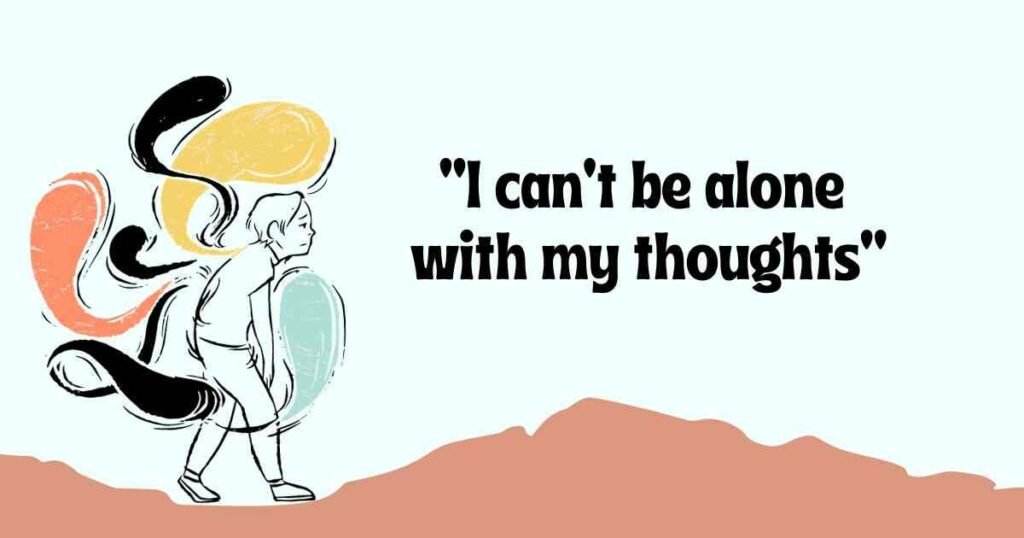In the relentless rhythm of modern life, do you desire a moment of silence? That elusive pause where the digital hum fades and you’re left alone with your thoughts and your essence? Yet, the idea of being by oneself can be daunting. Why does it make us uneasy? Why I can’t be alone with my thoughts?
The article delves into the intricacies of this modern problem, explores challenges and real-life anecdotes, and offers practical insights to find comfort and growth in moments of solitude.
Embracing discomfort, setting up dedicated quiet spaces, and balancing social interaction helps in optimizing alone time.
Let’s start with solitude and isolation.
Solitude and Isolation: Two Faces of Alone Time
Solitude and isolation, while both involve being alone, differ significantly in their essence.
| Aspect | Solitude | Isolation |
| Definition | A positive and voluntary state of peaceful aloneness. | Involves physical aloneness but is marked by a lack of connection. |
| Emotional State | Favorable, self created and often beneficial for self-reflection and expansion. | Tends to be draining rather than replenishing, lacks the positive and enriching qualities of isolation. |
| Surface Similarity | Both involve being alone. | Both involve being alone, leading to confusion. |
| Crucial Distinction | Beneficial and constructive engagement with oneself. | Absence of connection, making it a less useful and rewarding experience. |
| Importance | Considered essential for mental well-being and resilience. | May lead to negative effects on mental health due to the lack of relationship and affirmative interactions. |
Knowing the distinction assures uplifting solo time.
Introspection alone may be enlightening and difficult.
The Challenges of Being Alone with Your Thoughts:
Contemplative solitude presents essential challenges that are often overlooked.
The Overwhelming Silence: Unpacking the Fear of Solitude
Solitude isn’t always the serene escape we imagine. Mind echoes loudly in alone, which can be frightening. It’s a bit like stepping into a room with a flickering light that exposes the uncomfortable corners of our minds.
No interruptions, just your unfiltered thoughts. Worries paint vividly on silence. Unfiltered solitude reflects one’s psyche.
The absence of external distractions amplifies internal dialogues, internal talks, and doubts, pushing people to face their deepest concerns.
Silence uncovers emotions’ rawness and fragility. One may face the unvarnished self without social masks.
Confronting the Uncomfortable Silence:

The discomfort of solitude is because of society’s aversion to silence and constant connectivity.
So, we’ve become conditioned to seek constant stimulation, fearing that silence may force us to indulge in aspects of ourselves we’d rather avoid.
The internal struggle to confront buried emotions and unaddressed worries leaves us feeling vulnerable and exposed.
We crave connection as social beings. However, it is essential to understand that being alone does not imply loneliness.
Fear of being alone with one’s thoughts also causes unsettling distress and vulnerability. It discloses difficult parts of the psyche may cause anxiety.
Yet, there’s a silver lining. It’s precisely in these uncomfortable moments that growth and self-awareness find fertile ground.
Riding the Ebb and Flow of Emotions:
Solitude often unveils and amplifies a spectrum of emotions, making them feel more intense. This heightened emotional state can be overwhelming, especially if you’re dealing with unresolved issues or difficult emotions.
It may be tempting to distract yourself rather than confront these emotions head-on.
Rather than suppressing or fearing these emotions, acknowledge them as signposts on your journey of self-discovery. Allow yourself to feel without judgment, recognizing that emotions, like waves, come and go.
The Modern Dilemma of Constant Connectivity:
Constant information and connectivity pressures hinder privacy.
Notifications, emails, and social media updates flood us, leaving little room for quiet contemplation.
The ability to disconnect and be alone with one’s thoughts is a skill worth honing in this digital age. The mind may sort through its clutter to identify significant ideas.
You may become more attuned to your surroundings. This heightened sensitivity can be overwhelming, especially if you’re not used to paying close attention to your thoughts and feelings.
Decision Fatigue:
Constantly being in your head can lead to decision fatigue. When you’re alone, you might find yourself analyzing and contemplating choices that might otherwise be straightforward.
Over-analyzing can turn small decisions into monumental tasks. It’s as if every option carries a life-changing decision.
The intricate web of thoughts, doubts, and considerations creates a cloud of uncertainty, affecting not only your decision-making but also your overall well-being.
When your mental energy runs out, your decisions suffer.
This might hinder productivity and lead to a sense of feeling stuck.
Potential for Rumination:
While alone, you may meditate on the same issues without making progress. This cycle can be detrimental to This pattern may harm your mental health and frustrate your resolution to find solutions or closure.
Be mindful of the risks of overthinking while seeking solitude.
The constant replay of concerns or uncertainties may create a mental loop, trapping you in a cycle of worry without offering a resolution.
Finding Comfort in External Validation:
Finding comfort in validation lessens the weight of solitude. When you’re alone, there’s a lack of immediate external validation. This absence can make it challenging to evaluate your ideas, beliefs, or decisions, and you might find it harder to gain perspective without external input.
It’s simple to get validation online from others through social media likes, comments, and shares. The feeling of affirmation from friends and followers can provide a temporary escape from inner turmoil.
However, relying solely on external validation can create a cycle of seeking constant approval and neglecting internal self-worth.
Develop a self-worth independent of others’ opinions. Taking the time to reflect on personal accomplishments and acknowledging one’s strengths can build resilience against the need for constant external validation.
Striking an optimal balance between external affirmations and nurturing internal self-validation promotes endurance and happiness.
Balancing Social Interaction:
While solitude has its merits, maintaining a balance with social interaction is essential. Nurturing relationships and engaging with others brings joy and shared experiences, contributing to a well-rounded life.
Discover the benefits of socializing without compromising your alone time.
The key lies in valuing both extremes of the spectrum and achieving balance – the lively network of social interactions and the tranquil state of being alone. So, greet the dance of companionship and solitude, cherishing their unique gifts to life’s journey.
People also read:
Don’t let anyone disturb your peace
When and Why Sometimes you have to remove yourself: Strategic Self-Removal
Tips for Optimizing Your Alone Time
Use silence for evaluation, personal growth, and prosperity.
Here are some ways to optimize your alone time:
1. Making time for solitude in your routine:
Prioritize alone time by setting aside specific periods in your schedule dedicated solely to yourself. Whether it’s early mornings or late evenings, find a time that works best for you and commit to it.
2. Face the discomfort:

Embrace the discomfort, and you may find that it becomes a gateway to understanding your deepest desires, fears, and aspirations. We must review our relationship with silence in order to navigate this uneasiness.
Acknowledging psychological aspects, appreciating the confusion, and seeking progress are key to handling solitude anxiety.
It’s not all rainbows and butterflies, but grasping the pain may make you more honest and grounded.
3. Setting up a dedicated quiet space:
Create a physical space where you can retreat and enjoy uninterrupted solitude. It could be an appealing household corner, a peaceful park bench, or even a local library.
Make sure this space is free from distractions and invites you to fully enter into quiet reflection.
4. Schedule Daily Solitude Time:
Plan regular alone time to foster self-awareness and reap the benefits without feeling lonely.
Evaluate your schedule, set boundaries, and arrange meaningful alone time. This intended social break can provide mental clarity, enabling people to approach their relationships and responsibilities with renewed energy and perspective.
5. Encouraging inquiry:
Use your alone time wisely by engaging in activities that encourage introspection. Find ways to be comfortable to confront their thoughts without seeking immediate outside reassurance.
This could include journaling, meditation, reading books that inspire personal growth, or practicing mindfulness exercises. These activities can help you gain clarity and enhance creativity and self-awareness.
5. Coping with Uncomfortable Emotions:
Coping with uncomfortable emotions can feel like an overwhelming task, especially when it seems impossible to be alone with our thoughts.
It’s normal to want to escape unpleasant sentiments, yet external influences can hinder us from learning and processing them.
You may develop mental strength through the ebb and flow of emotions. It helps you traverse your inner world and connect with others.
Engage in activities that bring joy.
Practice self-compassion and remind ourselves that feeling uneasy is part of the human experience.
6. Disconnecting from technology and distractions:
In order to truly make the most out of your alone time, it’s important to disconnect from the constant buzz of technology and other distractions.
Turn off notifications on your phone or put it on silent mode.
By eliminating external interruptions, you can fully immerse yourself in the present moment.
7. Happiness is being alone with your own thoughts:
Indulge in the beauty of one’s thoughts builds up a sense of pleasure and contentment, affirming the belief that happiness, at times, is truly found in the simple act of being alone with oneself.
Additionally, connecting with like-minded individuals through online communities or participating in group activities can provide a sense of companionship and help alleviate any feelings of loneliness or boredom while still allowing for individual introspection.
Follow these tips to create meaningful moments of solitude that will recharge your mind, nourish your soul, and ultimately lead to greater happiness and fulfilment in life.
Alone time is vital to self-care, mindfulness, and personal development, not selfish.
Key Takeaways:
- Accept the uneasiness of silence and internal dialogues.
- Constant digital connectivity hinders peace.
- Regularly being in your head causes decision fatigue and overthinking.
- Seek a balance between external validation and nurturing internal self-worth.
- Fostering stability with social interaction contributes to a well-rounded life.
- Create dedicated quiet spaces, schedule regular solitude, and take part in meditative activities.
References
bryankramer.com – The Difference between Solitude and Isolation
evolutioncounseling.com – Isolation Versus Solitude
Autophobia: Symptoms, Causes & Treatments